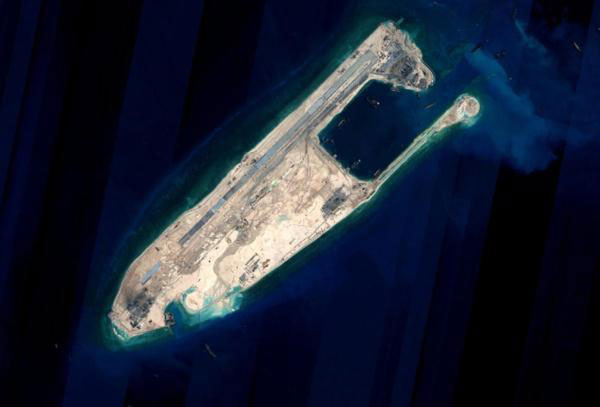Philippines' arbitration case built on false pretext
Updated: 2016-05-25 07:45
By Jiang Wei(China Daily)
|
|||||||||
 |
|
This satellite image shows the Yongshu Jiao of China's Nansha Islands. [Photo/Xinhua] |
In its compulsory arbitration proceedings with respect to its disputes with China in the South China Sea, the Philippines has accused China of interfering in the Philippines exercising sovereignty and jurisdiction in its territorial waters. The Philippines claims that the region extending 200 nautical miles from its coast, except the 12-nautical miles of high-tide land, is its exclusive economic zone and continental shelf.
It also claims that China's claim of historical rights within the nine-dash line in the South China Sea violate its sovereignty and jurisdiction over the non-biological resources in the seabed and ocean bottom.
But there are mistakes in its claims, as well as in its proving of them.
The Philippines' claims are based on a false pretext. China has indisputable sovereignty over the Nansha Islands and the domestic laws of China quoted by the Philippines make it clear that China's territory includes the Nansha Islands.
Before the United Nations Convention on the Law of the Sea, the Institute of International Law raised the concept of the regime of islands as early as 1924; this was later included in the Convention. Even the regime of islands defined by the Convention does not exclude the rights of Islands that are considered by customary international law as a group.
Therefore, the Nansha Islands as a whole have the right to claim territorial sea, economic exclusive zone and continental shelf. Besides, UNCLOS does not exclude continental countries from exercising the system in their overseas islands and many countries govern their overseas islands as a whole.
The Philippines is also distorting the facts by saying that China did not claim historical rights within the nine-dashed line until 2009. On that basis, it claims exclusive jurisdiction over the resources in the said zones and claims China has opposed it exploring for oil at Liyue Tan (Reed Bank).
The fact is, China issued a statement opposing oil exploration at Liyue Tan, which is part of Nansha Islands, as early as 1976.
The Philippines also claims that China has deprived Philippine fisherpersons of their traditional livelihood, which is against UNCLOS. By "traditional livelihood" they mean fishing rights; they even quoted a 1734 map, drawn by Spanish colonialists, to prove that Philippine fishing there can be dated back to the colonial era. They also quoted two documents, one in 1953 and one in 1973, to support their claim.
The problem is, they quoted the map from an academic essay in 2014, which in itself does not prove anything. The two documents they cited only have conclusions such as Huangyan Island being a main reef fishing area for the Philippines, without any actual support. They lack supportive materials such as what kinds of fishing vessels they use, their maritime charts, materials about the fishing staff, as well as what fish products they have.
China has sovereignty over Huangyan Island; therefore it has the right to chase away Philippine fishing vessels that intrude in the said maritime zones. By doing so China acts in accordance with international laws, and the actions it takes are common practice.
Therefore, the Philippines has committed several mistakes in trying to prove China "interfered" its exercising sovereignty and jurisdiction, and in the livelihoods of Philippine people fishing around the Huangyan Island.
Its arbitration proceedings is on the wrong pretext, distorted facts and is self-contradictory.
The author is an associate researcher at the National Institute for South China Sea Studies.
Related Stories
Some South China Sea arguments are just wrong: Ambassador 2016-05-24 23:25
Outsiders should respect regional order in South China Sea, says spokesman 2016-05-24 21:11
Vice foreign minister discusses South China Sea with US media delegation 2016-05-24 18:46
Coral coverage declined 80% in South China Sea 2016-05-24 10:19
Today's Top News
London's financial centre warns of dangers of Brexit
Russia blasts NATO for Cold War mentality
Vietnam, US adopt statement on partnership
Alibaba expands in Belgium amid protectionism
Eiffel Tower to become rental apartment for first time
Wreckage of crashed EgyptAir plane found at sea
Still learning
EgyptAir denies finding wreckage of missing flight
Hot Topics
Lunar probe , China growth forecasts, Emission rules get tougher, China seen through 'colored lens', International board,
Editor's Picks

|

|

|

|

|

|







